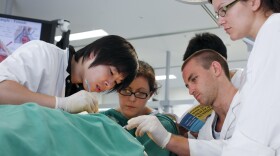Patients seeking an appointment with certain types of doctors need to be prepared to wait – especially if they want to see certain specialty physicians. Sometimes it can be months before the doctor has an opening. For dermatologists, the wait times can be particularly long, a problem which may be emblematic of larger issues plaguing the medical field.
WBAA called five different dermatologists in west-central Indiana, and the median wait time was 8 weeks, with some dermatologists scheduling more than half a year into the future. For comparison, other specialties, such as otolaryngologists or urologists, had median wait times about one-fourth to one-half that amount.
“It’s been a problem since the early nineties,” says Crawfordsville dermatologist Linda Spencer, who’s worked at her private practice for more than 25 years. For people in Montgomery County, she’s literally the only local option.
Spencer says her patients express their frustration about how long it takes to see her all the time.
“Certainly there are times we have to work people in if they are having a true emergency,” she says, “But it is a problem, and unfortunately as long as we have a maldistribution of dermatologists, it’s going to persist."
Spencer says the long wait times are a product of simple supply and demand. She says it takes a certain type of person to become a specialty physician. Those types of people—or their spouses—often choose to live and practice in urban areas, not places like relatively rural Montgomery County.
But though location may be a limiting factor, the number of students who want to be dermatologists isn’t.
“It’s a pretty popular specialty,” says Michael McKenna, Assistant Dean of Career Mentoring at Indiana University’s school of medicine. “It’s something that has a good lifestyle, it’s something that’s pretty lucrative…and certainly you have a great chance to change people’s lives and make a great impact.”
But, he adds, “your average medical student will probably not be able to get into a dermatology residency.”
The problem, says UC-San Francisco School of Medicine Dermatology Professor Jack Resneck, is that there just aren’t enough dermatology residency spots available to produce enough skin doctors.
“There are different factors that are pushing it, but supply and is a big piece of it,” Resneck says.
Funding for residency programs—dermatology or otherwise—comes from the federal government, through Medicare and Medicaid dollars. But that funding was frozen in the mid-nineties as part of the Balanced Budget Act of 1997.
Because of the freeze, some hospitals have started to fund residency slots independently. And Resneck says that’s led many specialties to compete for scarce resources available to fund residency programs – with some losing out.
“Dermatology, being a small specialty, hasn’t been able with those limited resources to compete for increases,” says Resneck.
And he says dermatology isn’t the only specialty suffering from the so-called “residency bottleneck”. Resneck mentions a concerning lack of primary care physicians, especially in rural areas – a problem Indiana has faced for years and one which some hospitals are trying to solve through new rural medicine programs.
Meanwhile, the *demand* for dermatologists has only increased. Sources attribute that to an increase in referrals from general practitioners—“they’re getting overwhelmed with things that are blocking the way from the patients who actually need to be there,” says McKenna—and increased rates of skin cancer diagnoses.
Crawfordsville doctor Linda Spencer says skin doctors can simply cure more problems now. But Phil Miller, Vice President of communications at the medical staffing and consulting company Meritt-Hawkins, has a less generous reason:
“In one sense, I would chalk it up to the vanity of the American public,” Miller says.
Miller says there’s been an increase in aesthetic and non-medical procedures, such as Botox, tattoo removal and body sculpting.
However, UC-San Francisco’s Jack Resneck points out cosmetic dermatology only counts for about 8 percent of procedures an average dermatologist performs.
And Miller says not only are there not enough doctors coming into the market, there are too many leaving the profession.
“Like a lot of other specialties, dermatology is aging,” he says. “So you have a lot of physicians that are getting up toward retirement age, possibly slowing down or retiring.”
Miller says dermatologists have offset the demand by using so-called “extenders,” such as physicians’ assistants or nurse practitioners. Linda Spencer in Crawfordsville says using one has made her job a lot easier, even though it still takes two months to make any kind of appointment.
In the meantime, many students and the people who could one day be their patients just have to wait.





